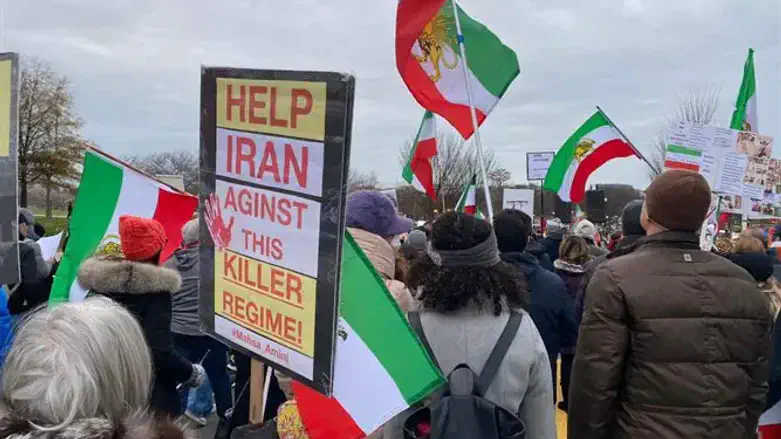
On March 8, 2025, International Women’s Day, thousands of Iranian-Americans are expected to converge on the Capitol in demonstration of support for assertive US policies toward the Islamic Republic. The coalition behind the event, the National Council of Resistance of Iran, (NCRI) has previously praised the Trump administration’s decision to re-implement a strategy of “maximum pressure” through economic sanctions, but has also urged the White House to go beyond this by expressing support for the democratic opposition movement that has been making significant strides inside Iran in recent years.
This past week, that call to action was echoed in the House of Representatives when a bipartisan group of 150 members introduced a resolution cataloging and condemning the Iranian regime’s malign activities and the corresponding efforts by the NCRI, its constituents and its affiliates to overturn the country’s theocratic dictatorship. Its points were further underscored in a speech to the congressional Iran Human Rights and Democracy Caucus by Maryam Rajavi, the NCRI’s President-elect, to serve as transitional president in the wake of the current regime’s overthrow.
Alluding to the principles of Rajavi’s longstanding ten-point plan for Iran’s future, the House resolution pointedly declares that that “the ultimate solution to ending the Iranian regime’s threats is the establishment of a secular, democratic, and pluralistic republic by the Iranian people and resistance.”
The forthcoming rally in Washington aims to raise awareness about the ways in which the US and its allies can help to achieve that outcome, not through war or direct intervention into Iran’s affairs, but simply by maintaining a firm, multilateral strategy for weakening Iran’s repressive institutions, holding its officials accountable for their abuses, and boosting the morale of an ascendant campaign for democracy and human rights.
That ascendance was clearly acknowledged in the House resolution and in Rajavi’s accompanying remarks, and will surely feature prominently in speeches on March 8. The occasion of that rally will naturally refocus attention on the central role of women in Iran’s most recent nationwide uprising, which began in September 2022 following the fatal beating of Mahsa Amini by morality police. That, in turn, reflects the enduring prominence of female activists in pro-democracy movement, as embodied by Mrs. Rajavi’s prospective transitional leadership.
At its peak, the 2022 uprising was internationally recognized as the greatest challenge to Iran’s theocratic dictatorship since its establishment in the wake of the 1979 Iranian revolution. But as the House resolution emphasized, this was only one of three similar-scale uprisings dating back to the end of 2017, all of which featured a strong female presence alongside slogans like, “death to the dictator, whether Shah or Supreme Leader,” which are closely associated with the NCRI’s main constituent group, the People’s Mojahedin Organization of Iran (PMOI/MEK).
The PMOI, or MEK, is responsible for a nationwide network of “Resistance Units” whose activities have only expanded and intensified in the wake of the 2022 uprising, despite the regime having largely suppressed that movement by killing 750 protesters and arresting another 30,000. Even now, the Islamic Republic is undergoing a surge of executions that many human rights organizations have attributed to the regime’s effort to terrorize the public into silence. Yet anti-government sentiment remains obvious throughout Iranian society, as does open defiance of forced veiling for women, among other restrictions on civic freedom.
All this is to say that the Islamic Republic is recognizably poised for another uprising. And considering that the regime already came to the brink of overthrow in late 2022, it is not overly optimistic to say that the next surge of popular unrest could very likely topple the regime, especially if this time, it is backed up by equivocal support from Western powers that share an expressed commitment to maximum pressure.
In her testimony this past week, Rajavi made it clear that her movement is not seeking money or weapons from the US or any other country; but she made it equally clear that a firm policy toward the mullahs’ regime could be just as effective. That policy begins with maximal enforcement of economic sanctions, but should go on to include explicit recognition of the Resistance Units’ actions as a legitimate fight against religious tyranny, consistent with the political rights outlined in the United Nations Charter, as well as the US Declaration of Independence.
Viewed through that lens, the Iranian march on Washington on March 8 should be universally recognized as conveying a vital message of freedom, which no lawmaker or citizen of a democratic nation should hesitate to embrace. What’s more, it comes at a time when endorsement of that message could have the greatest possible effect, because Iran’s clerical regime remains mired in crises from which it has no immediate route to escape.
As Rajavi said in her remarks to the Iran Human Rights and Democracy Caucus, “The situation of the Iranian society is explosive. During its 46-year rule, the religious fascism has never been so weak and fragile.” It only remains to be seen whether the US and the Western world as a whole will have the political courage to take simple steps toward exploiting that weakness and helping the Iranian people rid the world of the mullahs’ regime once and for all.
Mr. McColmis an author and President of the Institute for Democratic Strategies and was the Executive Director of the Freedom House.